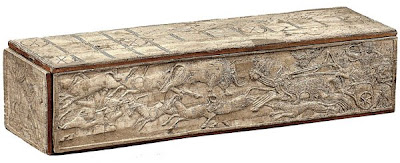 We'll be too late in New York (not arriving until May 19) to see this exhibition at the Met. Damn! Image: Photo: Jürgen Liepe; Staatliche Museen zu Berlin, Aegyptisches Museum und. Game Box with Chariot HuntEnkomi, Tomb 58; Late Bronze Age, ca. late 13th-12th century B.C. (© The Trustees of the British Museum; The Trustees of the British Museum, London )
As far as I am aware, the oldest known twenty squares board was found at Ur and dates to about 2600 BCE; the "serpent" game board laid out in the same style at the Ur game board was uncovered at Shar-i Sokhtah (the "Burnt City"), located in the borders area in southeast Iran where Pakistan and Afghanistan all merge, and dates to about 2400 BCE. This board demonstrates the long "tail" of 8 squares that was long in use on Egyptian twenty squares game boards.
Goddesschess folks have always been big fans of cross-cultural contacts and interconnectedness as a basis for explaining the existence of a sort of "universal" iconography in board games in cultures across half the globe and separated by many centuries. This exhibit demonstrates the influence of far-reaching trade and cultural contacts most beautifully and concretely - in the artifacts left behind. Check out the online review of "the Art of Foreign Influence" at Archaeology Magazine.
We'll be too late in New York (not arriving until May 19) to see this exhibition at the Met. Damn! Image: Photo: Jürgen Liepe; Staatliche Museen zu Berlin, Aegyptisches Museum und. Game Box with Chariot HuntEnkomi, Tomb 58; Late Bronze Age, ca. late 13th-12th century B.C. (© The Trustees of the British Museum; The Trustees of the British Museum, London )
As far as I am aware, the oldest known twenty squares board was found at Ur and dates to about 2600 BCE; the "serpent" game board laid out in the same style at the Ur game board was uncovered at Shar-i Sokhtah (the "Burnt City"), located in the borders area in southeast Iran where Pakistan and Afghanistan all merge, and dates to about 2400 BCE. This board demonstrates the long "tail" of 8 squares that was long in use on Egyptian twenty squares game boards.
Goddesschess folks have always been big fans of cross-cultural contacts and interconnectedness as a basis for explaining the existence of a sort of "universal" iconography in board games in cultures across half the globe and separated by many centuries. This exhibit demonstrates the influence of far-reaching trade and cultural contacts most beautifully and concretely - in the artifacts left behind. Check out the online review of "the Art of Foreign Influence" at Archaeology Magazine.
Friday, January 30, 2009
13th Century BCE Twenty Squares Game Board
 We'll be too late in New York (not arriving until May 19) to see this exhibition at the Met. Damn! Image: Photo: Jürgen Liepe; Staatliche Museen zu Berlin, Aegyptisches Museum und. Game Box with Chariot HuntEnkomi, Tomb 58; Late Bronze Age, ca. late 13th-12th century B.C. (© The Trustees of the British Museum; The Trustees of the British Museum, London )
As far as I am aware, the oldest known twenty squares board was found at Ur and dates to about 2600 BCE; the "serpent" game board laid out in the same style at the Ur game board was uncovered at Shar-i Sokhtah (the "Burnt City"), located in the borders area in southeast Iran where Pakistan and Afghanistan all merge, and dates to about 2400 BCE. This board demonstrates the long "tail" of 8 squares that was long in use on Egyptian twenty squares game boards.
Goddesschess folks have always been big fans of cross-cultural contacts and interconnectedness as a basis for explaining the existence of a sort of "universal" iconography in board games in cultures across half the globe and separated by many centuries. This exhibit demonstrates the influence of far-reaching trade and cultural contacts most beautifully and concretely - in the artifacts left behind. Check out the online review of "the Art of Foreign Influence" at Archaeology Magazine.
We'll be too late in New York (not arriving until May 19) to see this exhibition at the Met. Damn! Image: Photo: Jürgen Liepe; Staatliche Museen zu Berlin, Aegyptisches Museum und. Game Box with Chariot HuntEnkomi, Tomb 58; Late Bronze Age, ca. late 13th-12th century B.C. (© The Trustees of the British Museum; The Trustees of the British Museum, London )
As far as I am aware, the oldest known twenty squares board was found at Ur and dates to about 2600 BCE; the "serpent" game board laid out in the same style at the Ur game board was uncovered at Shar-i Sokhtah (the "Burnt City"), located in the borders area in southeast Iran where Pakistan and Afghanistan all merge, and dates to about 2400 BCE. This board demonstrates the long "tail" of 8 squares that was long in use on Egyptian twenty squares game boards.
Goddesschess folks have always been big fans of cross-cultural contacts and interconnectedness as a basis for explaining the existence of a sort of "universal" iconography in board games in cultures across half the globe and separated by many centuries. This exhibit demonstrates the influence of far-reaching trade and cultural contacts most beautifully and concretely - in the artifacts left behind. Check out the online review of "the Art of Foreign Influence" at Archaeology Magazine.
Subscribe to:
Post Comments (Atom)





































No comments:
Post a Comment